Follow in the footsteps of our ancestors
[Religious Reform] What I saw and thought during the 500th anniversary trip of the Reformation
Picture/Wen Yingqian

2017 marks the 500th anniversary of the start of the Reformation by Martin Luther. Protestant believers around the world, especially in Germany and nearby countries, are celebrating in different ways. Tourism in countries related to the Reformation is even more intense. We were fortunate enough to participate in the religious reform tour from March 27 to April 8, 2017. We benefited a lot from having a better understanding of the background and movement process of the religious reform.
This religious trip was planned and narrated by Pastor Zhang Linzhi of the Chinese Bible Church in Maryland, USA. Brother Sun Shusen served as the contact person. The Jerusalem Travel Agency in Taiwan, which specializes in tourism related to Christian history, was asked to arrange the trip and tour guide (Brother Chen Simai). A total of thirty-eight members took part in the trip, focusing on the life stories and pastoral experiences of the pioneers of the religious reform, starting from the Czech Huss who was condemned as a heretic by the Holy See and burned to death in 1415, to Luther, Zwingli and others. Calvin and others, this trip lasted for thirteen days and visited twenty-five cities.
The narrative in this article roughly follows the historical trajectory of the Reformation, rather than an itinerary, and divides it into Lutheran, Zwingli and Calvinist reform routes, reflecting the ins and outs of the Reformation. Due to space limitations, only nineteen cities that are closely related to the religious reform are briefly described.

▲Travel route map.
1. Luther’s Reformation Movement
The main places where Luther was active throughout his life were Eisleben, Erfurt, and Wittenberg.
asribbon
It is a town in the German state of Saxony-Anhalt. It is the place where Luther was born (November 10, 1483) and died (February 18, 1546). House, St. Peter and Paul Church where he was baptized the day after his birth, and St. Andrew's Church where he gave his last sermon. In 1997, the town was listed as a World Heritage Site by the United Nations Educational, Scientific and Cultural Organization (UNESCO). We visited the Luther Birthplace Museum and Luther's resting home. It takes a lot of courage and perseverance to imagine that a great master was born and rested here, but traveled across Europe to promote reforms.
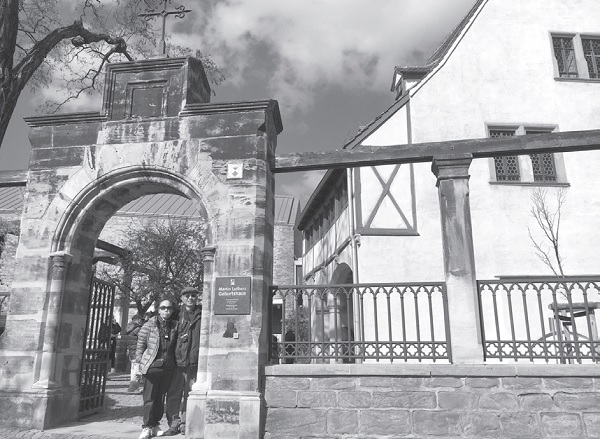
▲Esriben, Luther Birthplace Museum.
Evert
It was the place where Luther received his education at the university and decided to become a priest. In 1501, Luther entered Evert University at the age of seventeen and obtained a Master of Arts degree four years later. On July 2, 1505, Luther was almost struck by lightning on his way back to school. In his critical fear, he shouted to Saint Anna, the patron saint of miners, and vowed to become a monk if he was rescued.
After Luther escaped from danger, he fulfilled his promise and entered the local Augustinian monastery five days later, and was ordained a priest in 1507. He practiced hard in the monastery and confessed his sins diligently, but he often could not get the peace of forgiveness. Luther met Rector Johann von Staupitz (1460-1524) at the monastery in Evert, who became his mentor who encouraged and supported him.
Wittenberg
It is the capital of the Saxony territory. Frederick the Wise, Elector of Saxony (1463-1525) founded the University of Wittenberg in 1502 and hired Staupitz as provost. Strauss admired Luther's academic talent and encouraged him to enter Wittenberg University to continue his studies. Luther received a bachelor's degree in biblical studies in 1508, a bachelor's degree in grammar in 1509, and a doctorate in theology in 1512, and taught at the school. In 1510, Luther was sent to Rome by the religious order to discuss the issues of the religious order. He was very disappointed with the corruption of the Holy See, which also gave him a close understanding of church issues. His teaching experience at the University of Evert, the Order, and the University of Wittenberg and his knowledge of the Holy See provided him with good equipment to carry out the Reformation later in life.
In 1517, the Holy See promoted a large-scale sale of "pantal indulgences" of indulgences (to redeem the penalties of all sins committed in the past). Luther couldn't stand the corrupt behavior of the Holy See. On October 31, the day before All Saints' Day, he posted a "big-character poster" in Latin on the door of the Wittenberg Castle Church, listing the "Ninety" objections to the sale of indulgences. Five Essays", soliciting academic debate. Immediately, someone translated it into German and printed it using the movable type printing technology invented by Gutenberg about seventy years ago. It soon spread to Germany and other European regions, becoming a ignition point and triggering a series of religious movements. reform movement.
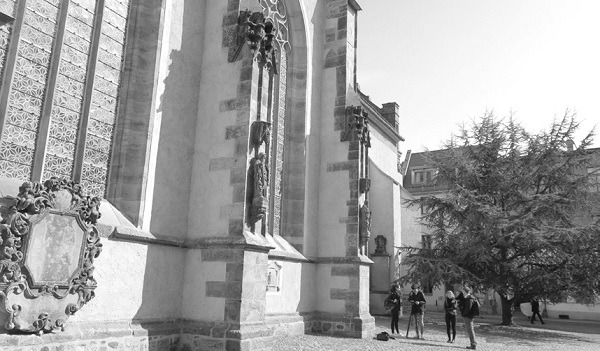
▲St. Mary’s Church in Wittenberg, where Luther preached.
The success of Luther's Reformation was due to the protection of political forces. Frederick the Wise supported the reforms of Luther and his "fellow travelers" and protected Luther's life. Otherwise, Luther would have been condemned as a heretic by the Holy Roman Emperor and the Holy See like Hus, the pioneer of the Reformation a century ago. put to death.
After the "Ninety-five Theses" became famous in 1517, the Reformation was raging, and Luther remained in Wittenberg. At first he only criticized the practice of indulgences and still respected the authority of the Holy See. However, subsequent developments caused Luther to completely break with the Holy See.
On June 15, 1520, the Pope issued an edict ordering the burning of all Luther's books and ordering Luther to withdraw all his remarks within sixty days, otherwise he would be excommunicated. This is an extremely serious punishment, and according to the Holy See, those who are excommunicated can never be redeemed. On the 60th day after the edict was delivered, on December 10 of that year, Luther and his teachers and students burned the edict and canon law at the gate of the city, openly confronting the Holy See. Wei City officially became the birthplace of the Reformation and the most important Protestant center in Europe at that time.
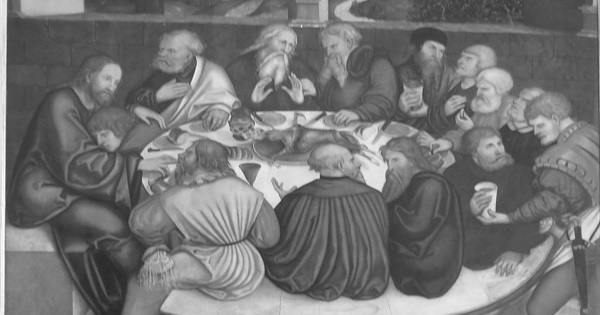
▲The mural in St. Mary's Church in Wittenberg shows the famous reformers having dinner with Jesus.
The Wittenberg Castle Church is also where Luther and Philipp Melanchthon (1497-1560), another reforming general, combat partner, and professor of theology at Wittenberg University, are buried. There are two tombstones inside. The following inscription is engraved on Luther's tombstone: "Here buried is Martin Luther, doctor of divine theology, who died in his hometown of Eisliben on February 18, 1546, at the age of sixty-three years and two months. Ten days."
We admire our ancestors in front of their tombstones. Luther and Melanchthon only lived to the age of sixty-three (already considered old at the time). They participated in the Reformation movement for nearly thirty years, risking their lives to shake up the world and return the church to orthodoxy and become God's A loyal servant whose name will last forever. Later, in order to commemorate Luther's great achievements, the official name of Wittenberg was changed to Lutherstadt Wittenberg.
Augsburg
The city played an important role during the Reformation. On August 7, 1518, Luther received a summons from the Holy See requiring him to appear in court in Rome within sixty days to respond to charges of heresy and disobedience. For Luther, this trip will be full of dangers and his life will not be saved. Through Frederick's mediation, Luther was able to be examined privately by Cardinal Thomas Cardinal Cajetan (1469-1534) during the Imperial Diet held in Augsburg from October 12 to 14, and received the approval of the Catholic Church. The personal safety guarantee given by Zong. Cajetan met with Luther at the private residence of the wealthy businessman Fogger, where he was staying, and asked Luther to repent. Luther opposed Cajetan's emphasis on the pope as the interpreter of the Bible and that the pope was above everything else in the council and the church. The two sides broke up unhappy.
Twelve years later, in April 1530, Lutheran theologians and electors came to Augsburg to attend another imperial council. At that time, Luther was still being sentenced for being heresy at the earlier imperial council in Worms. While wanted, he was not allowed to go to Augsburg to hold an imperial meeting, so he hid in Coburg, the southern end of the Electorate of Saxony, to remotely control the progress of the meeting. On June 25 of that year, the electors and theologians who supported Luther announced the "Augsburg Confession" (Augsburg Confession) at the meeting, which represented the general summary of Luther's theology and a great political victory for Lutheran believers. .
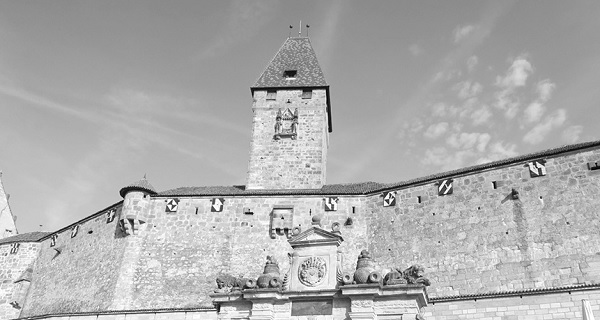
▲Luther was in Coburg during the Imperial Congress of Augsburg in April 1530.
On September 25, 1555, more than nine years after Luther's death, Holy Roman Emperor Charles V and the Smargaarden League signed the Peace of Augsburg, which provided legal protection for religious minorities in the empire. Allow princes from various places to choose between Lutheranism and Catholicism as the local official religion. Calvinism was not allowed until the end of the Thirty Years' War (1618-1648) and the signing of the Peace of Westphalia, at which point the Reformation was fully recognized.
The St. Ulrich's and St. Afra's Abbey we visited in Augsburg is a historic Benedictine monastery in Germany. It was founded in the 10th century. When it was disbanded in 1802, the order had an area of 112 square kilometers, which shows the great power of the Catholic Church. In addition, we also visited St. Anne's Church and the former site of the Bishop's Palace where the Augsburg Confession was published. We saw that the luxury of the Catholic Bishop's Palace in the past was in sharp contrast with the austerity of the ordinary monks' life.

▲Augsburg, the famous Catholic monastery St. Ulrich's and St. Afra's Abbey.
Leipzig
The second largest city in Saxony, Germany and the former East Germany, has many Baroque-style buildings and has given birth to many writers, philosophers and artists, such as Goethe, Nietzsche, Leibniz, etc. Bach, the father of musicians, worked in the St. Thomas Church here (1723-1750) and was buried in it. Musicians Wagner, Mendel and Schumann were active in the city. The Nicholas Church is the largest church in Leipzig and the birthplace of the East German revolution in 1989. The collapse of the Berlin Wall overnight was related to the activities of this church. In Leipzig we visited St. Thomas' Church, the Town Hall, and the Nicholas Church.
From July 4 to 27, 1519, Luther and his party held a great debate with Johann Maier of Eck (1486-1543), a theology professor at the University of Leipzig. He was Luther's old friend and an outstanding Catholic scholar. After Luther published theses, he published a series of articles opposing Luther's views and invited Luther's colleague Andreas Karlstadt, 1486-1541) went to Leipzig for debates, Luther and Melanchthon and many students from Wittenberg University also participated. The two sides reached a stalemate and had to adjourn the meeting. Meyer warned Luther that he was following the same path as Huss had done 100 years earlier. In February 1520, Luther declared: "We are all Hussites, we just don't know it." The two sides formally broke off, leading the Pope to issue a bull on June 15, 1520, ordering the burning of all Luther's writings (as mentioned above). The Leipzig Debate made Luther more famous and the Reformation became more popular.
Prague
The capital of the Czech Republic, the hometown of Jan Hus (1372-1415), the pioneer of the Reformation. Hus was a Czech religious thinker, philosopher, reformer, and former president of Charles University in Prague. Starting from 1402, Hus preached in Czech in the Bethlehem chapel, allowing lay believers and clergy to receive the Holy Body and Holy Blood together. He was regarded as a heretic by the Vatican, and he was excommunicated in 1411; in 1414, he was excommunicated by the German Constantine The synod found him guilty, and he was burned at the stake there on July 6 of the following year at the age of forty-three. A hundred years later, Luther, without realizing it, adhered to similar theological theories as Huss, opposed the perverse practices of the Catholic Church, and triggered the Reformation, but it succeeded. In 1999, the Roman Catholic Church apologized and vindicated Hus.
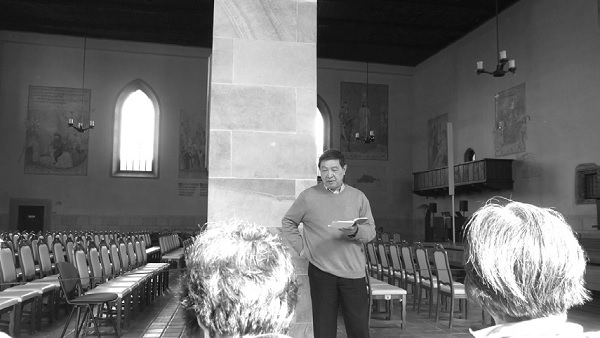
▲The tour group worshiped on Sunday at the Bethlehem Lecture Hall in Prague, which was the church where Huss preached in the 15th century.
We happened to travel to Prague on Sunday, April 2, and specially arranged to hold Sunday worship at Bethlehem Chapel. Pastor Zhang Lin received the sermon and preached, and then visited various displays in the church, which was like returning to the historical scene. The mural shows the scene of Hus being burned to death, showing the cruelty of medieval Catholics towards those they considered heretics. Human beings often act on behalf of God and brutally kill dissidents. In particular, thought prisoners who are persecuted by political and religious forces still exist in modern times.

▲The statue of Czech reformer and martyr Hus in downtown Prague.
Worms
On January 3, 1521, Luther was officially excommunicated by the Holy See. Frederick the Wise Elector insisted on hearing Luther before deciding whether he was guilty, and obtained the consent of the new Emperor Charles V of the Holy Roman Empire to summon Luther and grant him a guarantee of safety. On April 17, 1521, Luther was tried at the Imperial Diet in Worms in front of all the princes and representatives of the imperial cities, and was asked to repent and retract his words of rebellion. After being allowed to think for a day, Luther stated the next day that he would not go back on his words unless someone could point out his error through Scripture. He is said to have said the following: "This is my position, I have no choice, God help me, amen."
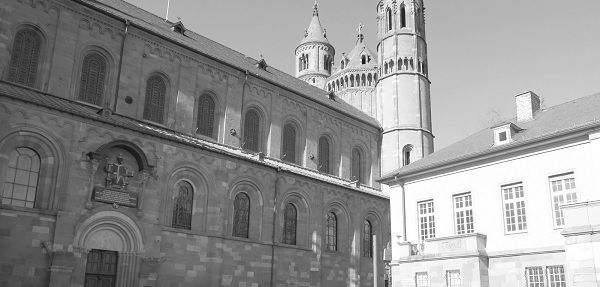
▲Wormuth, where Luther was tried in 1521.
On May 25, Charles V issued a verdict in which Luther was confirmed as a heretic. It was called the "Council of Worms". Four of the six electors signed it, but Frederick and the other did not. . We stopped to watch in front of the Parliament building in Worms, and also went to the nearby Reformation Memorial Park to pay homage to the statues of several important religious reformers. There are many tourists, the sun is shining, but there is a bit of cold wind; imagine that exactly 500 years ago, the atmosphere here was stagnant, and the thirty-eight-year-old Luther risked his life, stood firm, and defended his faith. His courage was admirable.
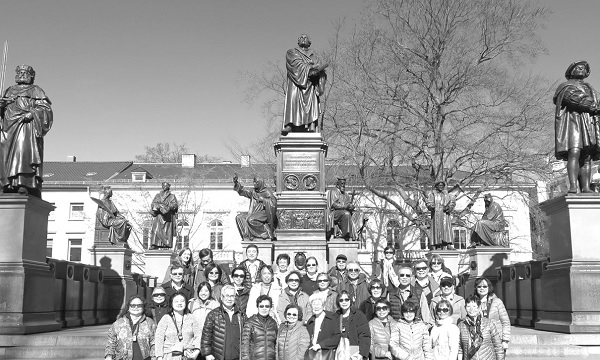
▲Womus Reformation Memorial Park, the tour group took a group photo in front of the statue of the religious reformers on March 27.
Eisenach
Near Eisliben, between 1498 and 1501, Luther studied at Eisenna Academy in preparation for admission to the University of Eifert. The most famous place here is Wartburg, which was originally the former residence of St. Elisabeth of Hungary (1207-1231) in the Middle Ages. There are many murals describing St. Elisabeth's good deeds.
Luther escaped unscathed after the Worms Conference and was not killed, but he disappeared and there were rumors that he had been killed. In fact, in order to protect Luther, Frederick sent troops to "kidnap" Luther on his way back to Wittenberg on April 26, and secretly hid him in Wartburg, where Luther lived when he was young, under the pseudonym George Jazz.
He lived in seclusion there for ten months and completed the first draft of the entire New Testament, which was translated from Greek into German and was officially published in September 1522. In 1534, he completed the translation of the entire German Bible. In addition to translating the Bible, Luther also wrote many works on theology and debates on his thoughts, and composed many hymns, the most famous of which is "The Lord is My Strong Fortress" written between 1527 and 1529 based on Psalm 46. It inspired many hearts during the Reformation; it is now used in mass in some Catholic churches.
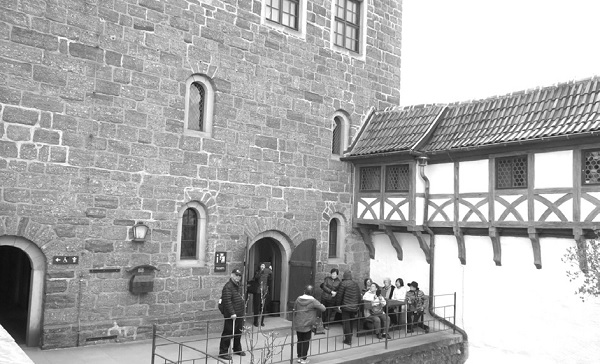
▲ Eisenawalt Castle, Luther lived in seclusion here for ten months starting in April 1521.
Speyer
A city located on the Rhine River in Rhineland-Palatinate, Germany, is the birthplace of the so-called "Protest Sect". On April 19, 1529, the Holy Roman Empire held an imperial meeting here to discuss the proposal to unfreeze the "Council of Worms" that persecuted Protestants. It was opposed by some participating princes and representatives of free cities, and they were called "protesters" in history ( Protestant), synonymous with Protestants. The main attraction here is the Catholic Speyer Cathedral, which commemorates St. Mary, the saint of Speyer; it was listed as a World Heritage Site in 1981.
Torgau
On the banks of the Elbe River in East Germany, northwest of Saxony. At the end of the Second World War, the Red Army of the United States and the Soviet Union met here in 1945. We visited its monument. The city has close ties with religious reform. In 1529, Luther and other Reformers wrote a treatise on church liturgy nearby, and in March 1530 they drafted the Torgau Confession. The electors set out from Torgau on April 3 and arrived in Coburg to meet Luther on April 23 before attending the Augsburg Imperial Conference (see above).
In 1544, Luther opened the world's first Protestant church in Torgau. In 1552, Luther's wife Katharina von Bora was involved in a carriage accident in Torgau and died of fractures. She was buried in St. Marien Church in this city. Catherine was a nun who left the convent due to the Reformation and married Luther in 1525. We visit Katharine’s former home, now a museum. Luther and other clergymen got married one after another, which became a tradition for later Protestant clergy to get married and start a family.
Coburg
As mentioned earlier, Luther lived in Coburg Castle for six months (from April 3, 1530) during the Imperial Council of Augsburg to remotely control the proceedings. During this time, Luther translated parts of the Old Testament into German.
We visit the magnificent castle, which houses Luther's accommodation room, chapel, and chariot and weapons museum. The various types of chariots and murderous weapons are impressive, showing the scene where human beings are killing each other and the people are living in dire straits. The religious reform movement blossomed and bore fruit everywhere, but it also brought about ideological shocks and divisions, and caused many political struggles and later religious wars, which were the sequelae of the religious reform.
Schmalkalden
Located south of Wittenberg. The princes and representatives of Europe who supported the religious reform were led by Philip I, Elector of Hesse, and formed the "Smakaden League" in this mountain town in 1531 to fight against the Catholic Church and the emperor. Luther and several reformers preached to these princes at St. George's Church and wrote the "Smackaden Confession" in 1537.
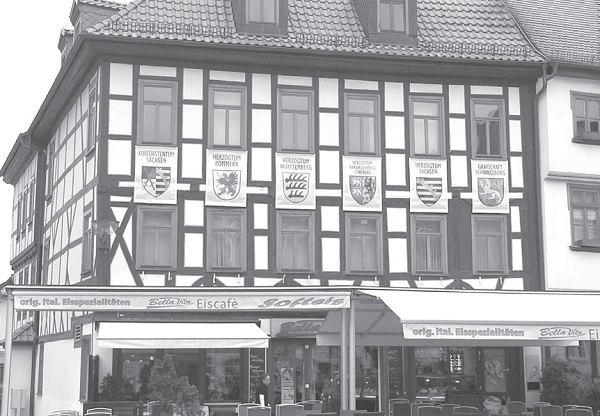
▲The Smakaden Alliance.
Spread of the Reformation
In 1527, Saxony designated the Lutheran Reformed sect as its official faith; by 1530, after the release of the Augsburg Confession, half of Germany became Protestant territory. For the rest of his life, Luther not only worked hard for religious reform, but also devoted himself to formulating and improving the rituals, creeds, music, etc. that later became the Lutheran Church.
In 1534, his translation of the Old and New Testaments in German was published. In the following years, Luther implemented a series of steady reform steps in Wittenberg, making Wittenberg an important town of the Reformation. On February 18, 1546, Luther died and returned to the Lord, ending his famous career. Acts 13:36 says: “After David had served the people of his generation according to the will of God, he fell asleep.” (small print in the Union Version) can be very aptly used to describe Luther’s contribution.
The Reformation movement led by Luther also influenced reforms across Europe. For example, Zwingli carried out a relatively independent religious reform in Zurich of the Swiss Confederation. In 1523, Zurich accepted Protestantism. The Church of England gradually became independent from the Church of Rome from 1529 to 1537, and began its own religious reform (to a lower degree). Calvin began to carry out religious reform based in Geneva in 1541, and later its influence spread to all parts of Europe. In 1537, Denmark and Norway accepted Lutheranism as their official faith, and it continued to spread in Northern Europe. France is predominantly Catholic, but Calvinist Protestantism still grows.
2. Zwingli’s Reformation Movement
Ulrich Zwingli, born in Switzerland on January 1, 1484, was a contemporary of Luther, but he died young at the age of forty-seven on October 11, 1531 due to participation in the war. He was educated at the Universities of Vienna and Basel, and became priest of Zurich Cathedral in 1518. He himself opposed traditional beliefs such as indulgences and the worship of Mary, and promoted the concept of religious reform. In 1522, he came to public attention for his opposition to fasting during Lent. A new liturgy was introduced in 1525, and the Reformation later spread to the Swiss Confederation and other regions.
At the end of 1530, Philip I of Hesse established the League of Smargaden, in which four city-states joined the alliance dominated by the Lutheran "Augsburg Confession". Due to the loose conditions of the alliance, Zurich, Basel, and Bern originally considered joining, but Zwingli could not accept it and wrote a letter to sternly refuse. This violated Philip's position, causing him to cut Zwingli off from the League, causing Zwingli's League of Citizens to lose all external allies in the religious conflicts of the Swiss Confederation.
In 1531, Zwingli's alliance intended to impose a food blockade on the Catholic city-states. Five Catholic city-states suddenly attacked Zurich. Zwingli died in Capel as an army chaplain. The theological thoughts, rituals and church systems left by Zwingli still influence the Reformed Church to this day.
Visiting the place where Zwingli converted, I personally felt that it was a pity that he persisted in his own ideas, was uncompromising, and resorted to drastic measures, which ultimately cost him his life. There should be no compromise on fundamental beliefs, but on secondary doctrines such as the method of baptism and the interpretation of the Holy Communion, everyone may have different opinions, but in fact they can tolerate and accept each other. Reluctance to compromise on minor doctrines may be unnecessarily causing division and conflict in the church.
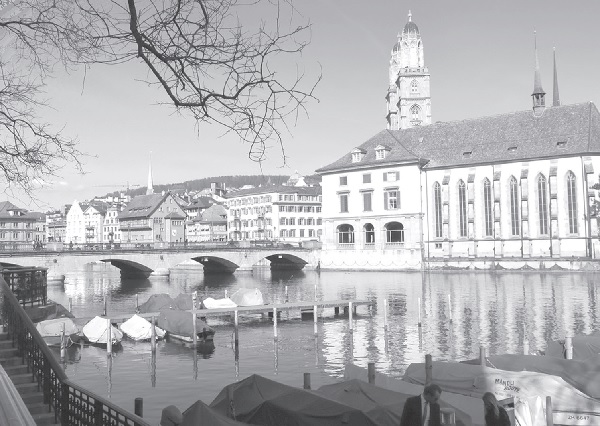
▲Zurich Cathedral, the base of Zwingli’s Reformation.
Zurich
In 1520, while Zwingli was serving at the Cathedral of Zurich, Switzerland, he began the religious reform in the German-speaking area. In 1523, he won a series of debates before judges that ultimately led to the local authorities authorizing the church to sever ties with the Roman pontiff.
We visited the Zurich Cathedral. Outside are the statues of Zwingli and the reformer Heinrich Bullinger (1504-1575) who succeeded his work. Bollinger was calm and resolute, unlike Calvin and Luther, who were as controversial as Calvin and Luther. His theological thoughts had a great influence on future generations.
Marburg
Marburg belongs to the German state of Hesse, about 100 kilometers away from Frankfurt in the west. In 1529, Elector Philip I of Hesse summoned Luther and Zwingli for a meeting at Marburg Castle to resolve doctrinal differences. Several Reformers were also present. Both sides have consensus on the previous fourteen and a half articles of faith, but they have different opinions on the meaning and views of the Holy Communion: Luther believes that the true essence of Christ comes in the Holy Communion (theory of consubstantiality), while Zwingli believes that the Holy Spirit Meal is just a symbolic commemoration (symbol theory). It is a pity that the two factions failed to integrate and broke up.
Malbork is the last and second stop of this trip. We started from the hotel early in the morning and went uphill to the castle. Looking down at the city of Malbork from the outside of the castle, the church steeple contrasts with the houses scattered in the woods, which is unique. Inside the castle there are many images illustrating the Malbork talks and a museum displaying historical artefacts. We then headed west back to Frankfurt - the starting and ending point of this trip. The city is worth a visit, but because it has little to do with the Reformation, I won’t describe it here.

▲Marburg, where Lutherans and Zwinglians debated theological issues in 1530.
3. Calvin’s Reformation
John Calvin was born in Paris on July 10, 1509 and died on May 27, 1564. He was the youngest of the three great reformers and believed in Catholicism in his early days. In 1523, Calvin went to university in Paris to study Latin; in 1528, he entered the University of Orleans to study law; in 1529, he transferred to the University of Bourges to study law; in 1531, he returned to Paris to study theology.
In 1533, he converted to Protestantism at the age of twenty-four (Luther was fifty years old at that time); in 1534, he went to Basel, Switzerland, where he published the first Latin edition of the Institutes of Christianity in 1536 (when he was only twenty-four years old) seven years old). In the same year, he was invited by the reformer William Farel (1489-1565) to Geneva to carry out the reform movement.
In 1538, he was forced to flee to Strasbourg for three years due to his strict reformation and conflicts with the municipal authorities. In 1541, he was invited to return to Geneva and established the Geneva Reformed Church, and formed the leadership of the Geneva city and local diocesan clergy. Institution, and until his death was president of the municipal clergy.
Strasbourg
Located in eastern France, across the Rhine River from Germany, it is the headquarters of many international organizations and houses many important institutions of the European Union and Europe. Many German and French celebrities such as Gutenberg, Calvin, Goethe, Mozart and Pasteur once lived in this city. Another important member during the Reformation period, Martin Baucer (1491-1551), participated in the Marburg Conference and worked here for twenty-six years (1523-1549).
During the Reformation in the 1520s, the city accepted Luther's teachings and in the next century founded the University of Strasbourg, now the second largest university in France. The Protestant purge of idols led to the destruction of many Catholic churches and monasteries. We visited the famous cathedral built in the twelfth century and St. Thomas' Church, where Calvin lived for about three years. The church is also where missionary Albert Schweitzer (1875-1965), known as the "Father of Africa", often played the organ.
Basel
The third largest city in Switzerland (after Zurich and Geneva), it is on the Rhine River, neighboring France and Germany. The famous Dutch humanist thinker and theologian Erasmus (1466-1536) taught in Basel and spent his later years. He published the Greek New Testament (using the newly invented printing press) in 1515, which became popular in Europe. He had a huge influence on Luther's thought. Initially Luther admired him, but later the two became enemies and blamed each other. Although Erasmus was a Catholic, he also sharply criticized the excessive arrogance of the Holy See and the Church.
The city converted to Protestantism in 1529. As mentioned earlier, in 1536, Calvin first published the Latin version of his work Institutes of Christianity here. We visited Basel Cathedral, built in the Middle Ages and containing the tomb of Erasmus.
Geneva
The second largest city in Switzerland, many United Nations-affiliated organizations and international organizations are located here. Due to the religious reform led by Calvin and others, Geneva is often called the "Protestant Rome". St. Peter's Basilica in Geneva, located in the old city, was Calvin's own church, where he pastored for 25 years.
We visited the College of Geneva and the University of Geneva founded by Calvin, stood on the podium where he once stood in St. Peter's Basilica, and visited Calvin's former residence. Next to St. Peter's Church is Knox Memorial Church, the birthplace of the Presbyterian Church. John Knox (1513-1572) was a Scottish Reformer and founder of the Scottish Presbyterian Church. He followed Calvin here.
Inside the University of Geneva, there is a 100-meter-long white Reformation Wall (Reformation Wall), built in 1909 to commemorate the 400th anniversary of Calvin's birth and the 350th anniversary of the founding of the University of Geneva. It is engraved with the inscriptions of Calvin and his contemporaries in the 16th century. The statues of ten famous Calvinist reformers from Switzerland and England are very spectacular. There is an inscription written in Latin on both sides of the white wall: "After darkness, light." (After darkness, light) is short and powerful, giving people a refreshing and expectant feeling of light. Looking at the fountains in the distance and the scenery on the other side of the broad Lake Geneva is like a paradise.
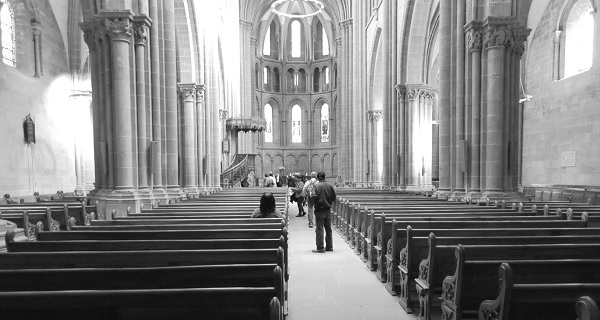
▲St. Peter's Church in Geneva, where Calvin pastored for 25 years.
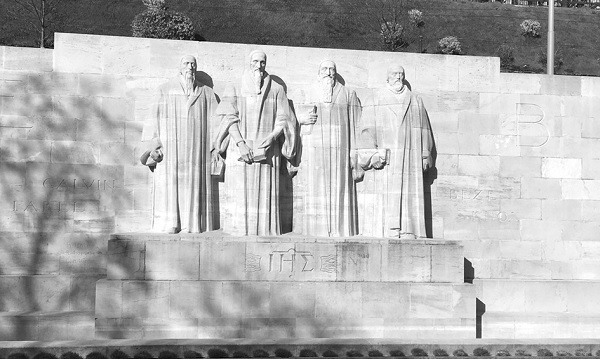
▲The wall of statues of Calvinist reformers at the University of Geneva.
Bern
The fourth largest city in Switzerland, its old town has become a UNESCO World Heritage Site today. The arcade building on Market Avenue is unique. There are many statues on the road, such as the Lady of Justice and the Baby Eater, as well as the former residence of Einstein. In addition, the clock tower at the top of Market Avenue is also world-famous for the robot that comes out to tell the time at regular intervals. Berne converted to Protestantism in 1528, and Berne Cathedral was the place where Zwingli converted.
4. Thoughts on the journey of religious reformation
The circumstances are very different.When Luther originally posted his ninety-five theses, his original intention was just to get the academic community to think and debate together, and not to confront the Holy See. Unexpectedly, it was like a spark that set off a prairie fire, pushing him onto the stage of history. Huss, who was a hundred years earlier than him, was not so lucky. He had the same thinking, but was burned to death and martyred.
Luther's courage is commendable.In both the private trial of Cardinal Cajetan and the public trial of the Imperial Council of Worms, Luther took a firm stance against threats from the Holy See and the Emperor, and was eventually excommunicated. After clarifying his thoughts, he broke with the Holy See without hesitation. It can be said that one man is invincible and invincible. But if Luther had not been protected by political forces, he would have been unable to defeat the persecutory power of the huge Catholic Church and the Holy Roman Emperor.
Those who have attained the truth will be helped much.Because Luther grasped the truth of the gospel and returned to the original meaning of the Bible, he attracted other reformers and many princes who supported the reform to fight together. The success of Luther's Reformation can be said to be the result of the right time, place and people. God used Luther and other reformers to bring faith back to the correct path.
Return to the Bible.Luther's concept of "everyone is a priest" broke the monopoly of the Catholic Church and priests on the interpretation of the Bible, allowing everyone to understand the Bible on their own and pray directly to God; secondly, the five solas - "faith alone", "faith alone" "Grace", "Scripture alone", "Christ alone" and "God's glory alone" return faith to the original form of the gospel of the first generation, influencing the development of the following centuries.
The religious reform had many impacts on later generations.Both Luther and Calvin advocated that the workplace is also a place to worship God, and that everything done is for the glory of God. These ideas developed a "Protestant ethical spirit", which contributed to the development of capitalism and caused The Industrial Revolution of the eighteenth century and the resulting economic development of advanced countries. The progress of modern science is also partly due to the Reformation. The Reformation also forced Catholicism to reform, which, while still different from Protestantism, was progressive.
Seeing is better than hearing a hundred times.The biggest gain from this trip was to turn the book knowledge I had learned about the Reformation into personal experience. Walking through these cities related to the Reformation and visiting Catholic and Protestant churches, you can understand the hardships of the Reformers at that time. They often risked their lives, but never looked back.
When did religious persecution begin?Several wars were also triggered during the Reformation, such as the Thirty Years' War (1618-1648), which evolved from the civil war of the Holy Roman Empire into a large-scale international war involving all Europe. About eight million people were killed, mostly in Germany. within the territory.
Human beings kill each other because of their different religious beliefs, especially the killing between Christians. This completely violates the command of Lord Jesus Christ for people to love one another. Religious persecution still occurs from time to time in modern times, mainly by Muslim extremists persecuting Christians. In November 2012, German Chancellor Angela Merkel declared that Christianity was the most persecuted religion in the world. It is unbelievable that modern people in the 21st century will still be massacred because of their different thoughts and beliefs.
Still need to fight for the Lord.Although transportation and information are now developed, people's hearts still need the gospel, souls still need to be saved, and we still need to do our best to preach the gospel. The example Luther gave us is to move forward courageously and fight to defend the truth with a fearless attitude.
 Author profile
Author profile
Wen Yingqian, holds the American Financial Analyst (CFA) certificate, is the chairman of the board of directors of the Christian Association of China Resources, and is the editor of the national talent unit of this magazine. He is currently an honorary professor in the Department of Economics and Finance at Dong Hwa University in Taiwan and the director of the American Chinese Outreach Ministry of Crown Financial Ministries in the United States.
